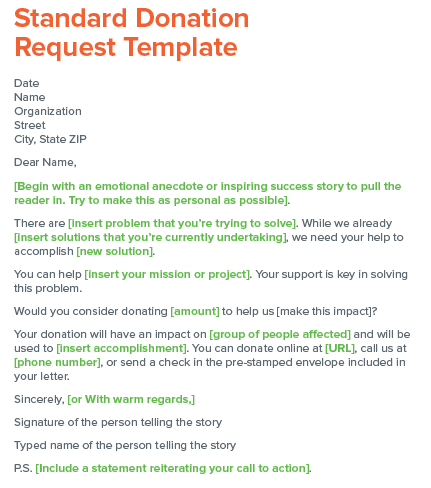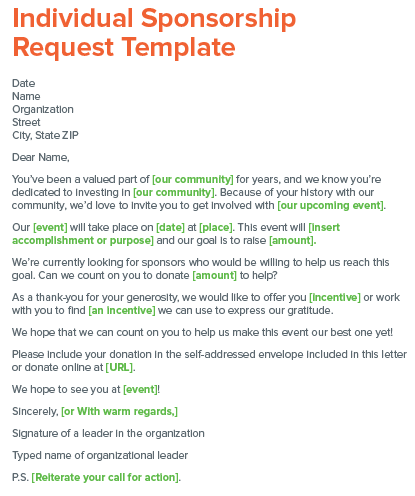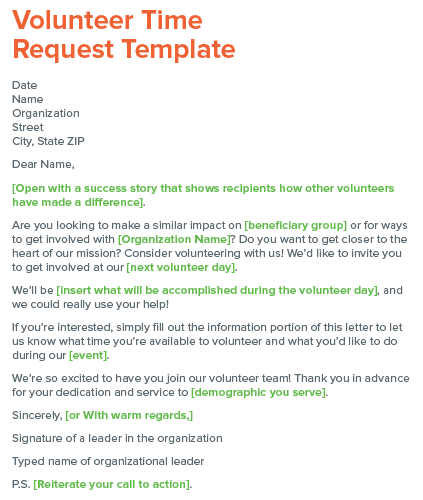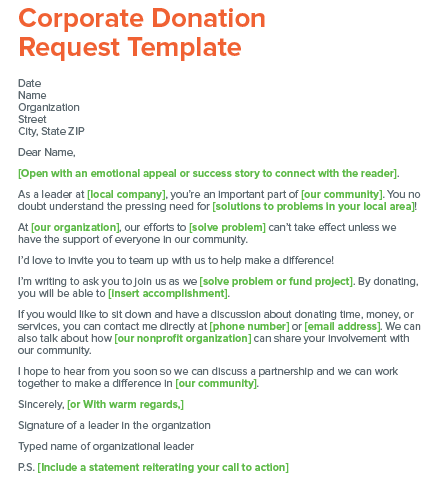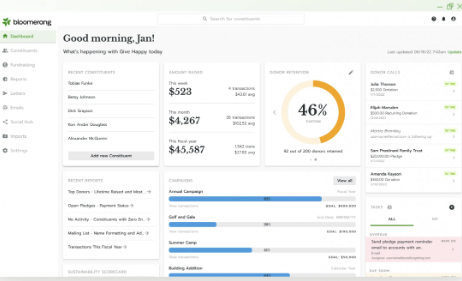Asking for donations is a fundamental aspect of nonprofit fundraising and is crucial for supporting your nonprofit’s mission. However, mastering the art of solicitation can seem daunting. You need to know who to ask, when to approach them, and how to make the ask effectively to secure donations. While this may seem overwhelming, there are several tips and strategies to streamline the process and enhance your success. This guide will help you get started!
- Who to ask for donations
- Ways to ask for donations
- When to ask for donations
- Best practices for asking for donations
- Templates for letters & emails
- Time-saving fundraising tools
- Frequently asked questions

Who to ask for donations
Individuals
Individual donors constitute a significant portion of philanthropic giving, making them a crucial target for donation solicitation. When approaching individuals for donations, consider the following strategies:
- Existing supporters: Start by reaching out to individuals who are already engaged with your organization as volunteers, attendees at events, or subscribers to your newsletters. These individuals have already demonstrated an interest in your cause and may be more receptive to donation appeals.
- Personal networks: Tap into the personal networks of your board members, staff, and volunteers. Encourage them to leverage their relationships and networks to solicit donations from friends, family members, colleagues, and acquaintances who share an affinity for your cause.
- Major donors: Identify individuals with the capacity to make significant contributions to your organization. These may include high-net-worth individuals, philanthropists, or community leaders who have demonstrated a commitment to supporting charitable causes. Cultivate personalized relationships with major donors and tailor your solicitation efforts to align with their interests and giving preferences.
When individuals donate to nonprofits, they not only contribute to causes they care about but also experience a sense of fulfillment, altruism, and connection to their communities. By highlighting the personal benefits of philanthropy, such as making a positive impact, creating social change, and leaving a lasting legacy, you can inspire individuals to become enthusiastic supporters of your organization’s mission.
Corporations
Corporate philanthropy presents valuable opportunities for nonprofit organizations to secure funding, partnerships, and in-kind support. When targeting corporations for donations, consider the following approaches:
- Corporate giving programs: Research corporations with established corporate social responsibility (CSR) programs or corporate giving initiatives. These companies may have grant programs, employee matching gift programs, or sponsorship opportunities available for nonprofits aligned with their philanthropic priorities.
- Partnership opportunities: Explore potential partnership opportunities with corporations that share synergies with your organization’s mission or target audience. Consider partnerships for cause-related marketing campaigns, corporate sponsorships of events or programs, or collaborative fundraising initiatives that leverage the resources and expertise of both parties.
- Employee engagement: Engage with corporations through employee engagement opportunities, such as workplace giving campaigns, volunteer programs, or corporate volunteer days. By involving employees in hands-on philanthropic activities, you can foster a sense of corporate citizenship and encourage ongoing support for your organization.
Corporations benefit from donating to nonprofits by enhancing their brand reputation, fostering positive relationships with stakeholders, and fulfilling their corporate social responsibility objectives. Through strategic philanthropic investments, corporations can demonstrate their commitment to social impact, employee engagement, and community development, thereby strengthening their position as responsible corporate citizens.
Foundations
Foundations play a vital role in supporting nonprofit organizations through grant funding and capacity-building initiatives. When seeking donations from foundations, consider the following strategies:
- Grant research: Conduct thorough research to identify foundations that align with your organization’s mission, geographic focus, and programmatic priorities. Utilize online grant databases, foundation directories, and philanthropic networks to identify potential funding opportunities.
- Grant proposal development: Develop compelling grant proposals that clearly articulate your organization’s mission, goals, programs, and impact. Tailor your proposals to align with the specific funding priorities and requirements of each foundation, demonstrating how your organization addresses critical needs and delivers measurable outcomes.
- Relationship building: Cultivate relationships with foundation staff, program officers, and trustees through networking events, meetings, and informational sessions. Establishing rapport and trust with foundation representatives can enhance your organization’s visibility, credibility, and likelihood of securing grant funding.
Foundations benefit from making donations to nonprofits by fulfilling their philanthropic missions, addressing pressing societal issues, and catalyzing positive change in communities. Through strategic grantmaking, foundations can leverage their resources, expertise, and networks to support innovative solutions, empower marginalized populations, and advance social justice initiatives, ultimately contributing to the collective well-being and prosperity of society.
Additional sources
In addition to individuals, corporations, and foundations, other potential sources of donations may include government agencies, community organizations, religious institutions, and civic groups. By diversifying your fundraising strategies and targeting multiple sources of support, you can maximize your organization’s fundraising potential and advance your mission effectively.

Ways to ask for donations
For nonprofits seeking support, mastering diverse donation solicitation methods is crucial. From in-person meetings to phone calls, direct mail, and email, each avenue offers unique advantages for connecting with donors. Understanding these methods allows organizations to optimize fundraising efforts and foster meaningful donor relationships.
Asking for donations in person
Asking for contributions in person isn’t a method that can be used for every single donation appeal, but they’re a great way to appeal to potential major donors and businesses. Face-to-face meetings are usually more extended, providing the perfect opportunity to lay out your organization’s mission and particular projects that need funding.
Because you can to interact with a prospect in person, you can better gauge their interests and concerns. Asking in person also adds a personal touch to your donation appeals, which leads to a more compelling pitch and deeper donor relationships.
Getting started
- Research your prospect.
- Form an initial relationship with your donor.
- Practice your pitch.
- Be prepared to adjust your ask amount.
Asking for donations over the phone
Most people associate phonathons with asking for donations over the phone, but phone calls are effective for everyday fundraising, too. If your organization doesn’t have the time or resources to visit hundreds or thousands of people, asking for contributions over the phone can be a great alternative.
Asking for donations over the phone still gives you the personal touch that comes with asking in person, but it’s easier and more cost effective than in-person meetings.
Getting started
- Use the resources available to you.
- Make your script personal.
- Give your donors a compelling reason to give.
- Don’t feel tied to your script.
- Listen to the person on the other end of the line.
Asking for donations on social media
Social media is a powerful tool for your organization because it allows you to reach a global audience quickly. From Facebook to Instagram to TikTok, there are many platforms with different audiences for you to reach out to for support. As long as you’re posting regular content alongside your donation appeals, you can bring in donations simply by asking for them on your social platforms. You can also reach more people with your appeals on social media if you use paid advertisement options offered by the different platforms.
Asking for donations on social media can be a quick and inexpensive way to reach a large crowd and directly point them to your online donation form.
Getting started
- Start posting regular content (not just appeals).
- Add a donation link to your page.
- Post updates with a link to your donation page.
- Engage with your donors on your posts.
- Track your insights and analytics.
Asking for donations with direct mail
Donation letters are most commonly used for formal fundraising appeals to companies, businesses, and foundations but, you can also use them to reach out to your more traditional donors who don’t have social media or email accounts for a more personal touch.
Because you have time to organize your thoughts before talking to donors, letters help you spell out your organization’s needs perfectly and demonstrate how much more money you require to reach your goal.
Getting started
- Start with a bold headline.
- Make your letter personal.
- Tell a story in the body.
- Make a sincere appeal.
- Don’t forget a return envelope.
- Say thank you in advance.
Asking for donations with emails
Emails are one of the most common ways for nonprofits to ask donors for contributions because you can send your appeal alongside regular updates on your organizations and events. Since many people check their email on their phones and laptops, emails can reach donors nearly everywhere.
Sending out emails is efficient and cost effective, enabling your organization to reach more people at a lower cost than other methods.
Getting started
- Create a bold subject line.
- Make your ask near the beginning.
- Describe why you’re asking for a donation.
- Include links to your online donation page and contact info for donors who want to give by mail or phone.
- Say thank you in advance.
When to ask for donations
- National giving days: Participate in national giving days like Giving Tuesday, a global day of generosity following Thanksgiving, to amplify your fundraising impact and engage donors through collective giving initiatives. Giving Tuesday, which is intended to be a “global generosity movement unleashing the power of people and organizations to transform their communities and the world,” has become wildly successful and is one of the biggest fundraising days of the year.
- Cause awareness Months: Identify relevant cause awareness months related to your organization’s mission or cause and leverage them to raise awareness and funds. For example, Breast Cancer Awareness Month in October or Mental Health Awareness Month in May can serve as platforms for targeted fundraising campaigns and outreach efforts.
- End of year: The end of the calendar year (November-December) sees a huge spike in charitable giving, with 30% of all annual donations made in December alone! The end of the year is the perfect time for nonprofits to start ramping up their fundraising efforts by asking for donations.
- Local events and festivities: Capitalize on local events, festivals, and community gatherings to connect with donors and promote your organization’s mission. Sponsorship opportunities, booth exhibitions, and event partnerships can provide exposure and fundraising opportunities.
- Nonprofit fundraising events: Events present the perfect opportunity to ask for donations in person without expending the extra time and resources to meet with donors individually. At your next fundraising event, highlight the good work you’re doing and ask attendees for their support.
- Anniversaries: Mark your nonprofit’s significant milestones such as founding anniversaries, program milestones, or achievements in impact metrics with special fundraising campaigns, events, or recognition initiatives.
- During specific projects: When your organization is growing, you may need to raise money for specific projects, such as new buildings or special events. Create a campaign dedicated to each specific project to ask your donors to give a little extra to fund your nonprofit’s growth.
- During crises: When a crisis occurs, your organization may urgently need funds to be able to directly help those in need. Whether providing relief for your community during a pandemic or raising funds to aid relief efforts from a natural disaster, your nonprofit should be prepared to ask for donations during a crisis.
By strategically timing donation solicitation efforts to coincide with seasonal trends, holidays, organizational milestones and more, nonprofits can optimize their fundraising impact and cultivate meaningful connections with donors throughout the year.

Best practices for asking for donations
Asking for donations can be a daunting task, but with the right approach and preparation, you can significantly increase your chances of success. These tips for each stage of the donation solicitation process—before, during, and after the ask—will help you navigate this essential aspect of nonprofit fundraising effectively.
Before the ask
- Understand that there is a process. Fundraising in all its forms requires a plan, a cohesive team, and a unified asking strategy.
- Know your audience. Before reaching out to potential donors, take the time to research and understand their interests, values, and philanthropic preferences. Tailor your approach and messaging to resonate with their motivations.
- Build relationships. Cultivate relationships with potential donors before making the ask. Engage with them through personalized communications, events, and updates about your organization’s work. Establishing rapport and trust beforehand can significantly increase the likelihood of a positive response.
- Start with your existing connections and move outward. Your staff, volunteers, and existing donors are the ones who care the most about your mission. Start by asking them for donations and then move to their connections.
- Thoroughly research your donor base. Don’t go into an ask unprepared! Research your donors to determine the right amount to ask for and the right way to ask.
- Know what story to tell. Storytelling helps you inspire your donors to give by letting them know the impact of their donation. Prepare an example of how your organization makes a difference through the donations you receive.
- Prepare your pitch. Craft a compelling narrative that effectively communicates your organization’s mission, impact, and funding needs. Highlight success stories, tangible outcomes, and the urgency of your cause to evoke empathy and inspire action.
During the ask
- Be genuine and authentic. Your donors want to give to an organization they can believe in. Communicate your sincerity during the donation appeal.
- Be clear and concise. When making the ask, be clear and concise in your communication. Clearly articulate why their support is vital, how their donation will be used, and the impact it will make. Avoid overwhelming potential donors with unnecessary details.
- Listen actively. During the conversation, listen attentively to the donor’s questions, concerns, and feedback. Demonstrate genuine interest in their perspective and address any hesitations or objections with empathy and transparency.
- Be prepared for something other than a “Yes!” Not everyone is immediately going to want to donate to your cause. Be prepared for “No,” “Maybe,” and everything in between.
- Explain what the funds will go toward. People don’t just throw money at nothing. Tell them why their donations are needed and what they’ll help accomplish.
- Provide options. Offer donors flexibility by presenting different giving options tailored to their preferences and financial capabilities. Whether it’s a one-time donation, recurring contribution, or in-kind support, providing choices can enhance their sense of ownership and engagement.
- Create a sense of urgency. People often give more if they feel the need is more urgent. Establish an end date for your campaign to increase the sense of urgency for donations.
After the ask
- Express gratitude more than once. Immediately after the ask, express sincere appreciation for the donor’s time and consideration. Regardless of the outcome, thank them for their support and commitment to your cause. Personalized thank-you notes or calls can leave a lasting impression.
- Follow up promptly. Follow up with donors promptly, regardless of their initial response. Provide additional information, updates, or answers to any questions they may have raised during the ask. Consistent follow-up demonstrates your organization’s commitment to transparency and accountability. Give donors examples of what their contributions went toward. Show pictures, tell stories, and give your donors a reason to donate again.
- Steward relationships. Continuously nurture relationships with donors beyond the initial ask through effective donor stewardship. Keep them engaged with regular updates, impact reports, and invitations to events or volunteer opportunities. Building a community of dedicated supporters is key to long-term fundraising success, and donor stewardship plays a pivotal role in fostering lasting connections and sustaining support for your organization’s mission.
- Offer other opportunities for engagement. Don’t just let your supporters sit in your donor pool. Invite them to events, encourage them to pursue volunteer opportunities, and engage with them outside of the fundraising appeal.
By implementing these tips before, during, and after the ask, you can enhance your organization’s fundraising efforts and cultivate lasting relationships with donors who share your vision for positive change. Remember, effective donation solicitation is not just about securing funds—it’s about building meaningful connections and driving sustainable impact.
Templates for fundraising letters and emails
Jumpstart your fundraising efforts with these expertly crafted letter templates, tailored to simplify the process of soliciting donations—or use them as a source of inspiration!
Standard donation request letter
The most basic fundraising letter you’ll write is for a standard donation. Your letters should differ depending on your relationship with the recipient. Standard donation letters can be used for your year-end fundraising push or during a specific branded campaign and should be personalized for each segment of donors, no matter the time of year.
Individual sponsorship request letter
Many organizations write letters to individuals and businesses requesting sponsorship for a specific event or fundraiser. These letters should explain exactly what the donation or sponsorship will help accomplish. They’re perfect for specific events or fundraisers that require significant backing.
Volunteer time templates
Volunteer time letters are requests for donations of time and effort. Your volunteers are crucial for your organization’s success. Invite them to work with you by using a letter. These letters can be used throughout the year but are most effective in preparations for a specific day or event.
Corporate donation templates
Corporate donation letters are sent to leadership members of local or national businesses or to the designated CSR coordinator at a corporation to seek monetary or in-kind donations from companies. While these letters may be sent on their own, they are often followed by an in-person meeting or phone call.
Time and money-saving fundraising tools
Having the right fundraising software and tools not only saves time, money and headaches, but also accelerates your nonprofit’s ability to secure more funds faster and more efficiently!
Mobile-responsive donation pages
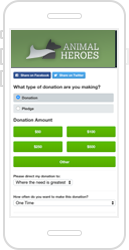
It’s all well and good if your donation form looks great on a computer, but does it function as well on a smartphone or tablet? Make sure that your donors aren’t pinching, scrolling, and zooming just to give to your organization, and invest in a mobile-responsive donation page design to start collecting contributions from on-the-go donors.
Text fundraising tools
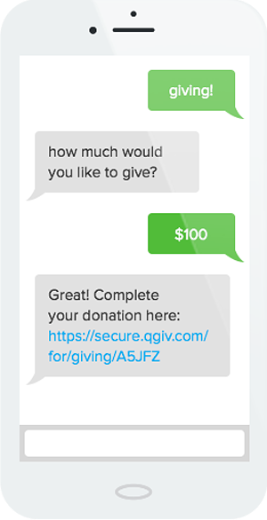
Fundraising events are great ways to interact with donors and raise more money, but most people only have credit and debit cards instead of cash or checks. Use text fundraising tools to encourage your donors to give without taking out their wallet at your next fundraising event!
Peer-to-peer fundraising pages
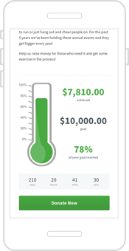
If you’re looking for a way to bring in more revenue and acquire more supporters, peer-to-peer fundraising. These fundraisers take advantage of your existing donor connections and put your donors in charge of their own fundraising efforts.
CRM integration
Make contacting your donors more efficient by integrating your fundraising platform with a CRM. CRMs help you track and automate communications with your donors and streamline the collection of data for your accounting team.
Learn more about Qgiv + Bloomerang’s full suite of fundraising tools and solutions here.

Asking for donations FAQs
Explore the ins and outs of asking for donations with these frequently asked questions:
Questions nonprofits have
1. When can a nonprofit start fundraising?
If your nonprofit is waiting on its 501(c)(3) status, you can still ask for donations.
However, those contributions aren’t tax-deductible until you are officially registered as a charitable organization with the IRS. It will be more beneficial to your organization to wait on fundraising activities until you’ve received your 501(c)(3) status from the IRS.
2. Do nonprofits need to register before they start fundraising?
A general timeline for registration goes like this:
- Register before you start asking for donations.
- Register in your home state (state of domicile) first and then in every state where you fundraise.
- If you accept online donations, register in New York and Florida because they require registration for any donations made, even if you aren’t actively asking for donations there.
- If you have an online donation form, register in every state you receive donations from. Your nonprofit can incur penalties and even felony charges for not properly registering. Research the specific requirements for each state you fundraise in.
3. How should a nonprofit promote an online donation page?
Consider promoting your online donation form on the “Ways to Give” page on your website, including links and information about it in your emails, and posting links on your social media platforms. You can also talk about your online donation page at events, include a QR code in your direct mail materials, and mention it during your in-person meetings and during phone calls.
4. What are the ethics of fundraising?
These are some industry standards that nonprofits should follow when fundraising:
- AFP’s Code of Ethical Principles and Standards
- National Council of Nonprofits’ Ethical Fundraising
- CASE’s Principles of Practice for Fundraising Professionals at Educational Institutions
- U.S. Department of the Interior’s Fundraising for Your Favorite Cause
In addition, it’s imperative for fundraisers and nonprofit entities to regularly assess their conduct and align it with the organization’s ethical code.
5. What is an annual fund and why do nonprofits need one?
An annual fund used to be known as a fundraising campaign that kicked off at the same time each year. It usually had a theme with coordinating promotional and marketing materials.
However, an annual fund is now considered to be a nonprofit’s overarching plan or strategy with many components and is crucial for fundraising success. An annual fund helps your donors establish regular giving patterns, ensures more regular revenue for your organization, builds a more robust database, and boosts acquisition, retention, and average gift size year over year.
6. How much of a nonprofit’s revenue can come from the general public?
Public charities must receive at least a third of their fundraising dollars from members of the general public. As such, you shouldn’t rely too heavily on donations from your board members or staff.
Questions donors have
1. Where can I find financial information about a nonprofit?
You can look up the annual IRS form 990 on Candid’s website (formerly GuideStar), ask for the past three audited financial reports, ask for the unaudited year-end financial statements (if audited reports are unavailable), and ask whether the nonprofit has previously received federal grant dollars.
2. How can I support a charity?
Contributing to nonprofits encompasses more than just monetary donations. Individuals can make a difference by volunteering their time, donating goods, or offering their skills and services. Whether it’s lending a helping hand at a local event, donating essential items to those in need, or utilizing professional expertise to support organizational initiatives, there are numerous avenues for making a positive impact beyond financial contributions.
3. Is it safe to give online?
Some donors might have reservations about giving online, and that’s understandable. However, it’s essential to note that most nonprofits prioritize the security of donor data by utilizing donation forms that adhere to Payment Card Industry (PCI) compliance standards. These stringent guidelines ensure that donor information is encrypted and cannot be compromised, offering peace of mind to donors. Look for donation forms displaying security logos and certifications, which serve as tangible evidence of adherence to PCI standards, further enhancing trust and confidence in online giving processes.
4. How can I participate in peer-to-peer fundraising?
Peer-to-peer fundraising is a way for individuals to get in on the fundraising process. If a nonprofit is hosting a peer-to-peer fundraiser, you can volunteer to be one of the fundraisers, create your own fundraising page, and share it with your friends, family members, and coworkers. This way, you help raise money for a great cause and participate in a fun fundraiser!
5. Can I claim my charitable contributions on my tax return?
As long as you have a donation receipt from the nonprofit, you can claim your charitable contributions on your taxes.
According to the IRS, your donation receipt (also known as a written acknowledgement) for a charitable contribution of $250 or more must contain the following information:
- The name of the nonprofit organization
- The amount of the monetary contribution
- A description (but not value) of non-cash contribution(s)
- A statement that no goods or services were provided by the organization, if that is the case
- A short description and good faith estimate of the value of goods or services, if any, that the organization provided in return for the contribution
- A statement that goods or services, if any, that the organization provided in return for the contribution consisted entirely of intangible religious benefits, if that was the case
Moreover, donors are eligible to claim deductions for cash, check, or other monetary gifts, provided they maintain specific written records.
6. Will a nonprofit spam me with information?
Whenever you give out your personal contact information, you run the risk of getting inundated with direct mail and emails. However, you can also specify your preferred communication channels whenever you donate to a nonprofit. Nonprofits don’t want to drive you away, but they won’t know how often to contact you unless you specify a preference.
Final thoughts
Effective fundraising requires careful planning, strategic execution, and ongoing engagement with donors. By implementing best practices and leveraging diverse solicitation methods, nonprofits can maximize their fundraising potential and cultivate meaningful relationships with supporters.
Donors play a pivotal role in driving positive change by contributing their time, resources, and expertise to support causes they care about. Addressing common questions and concerns related to fundraising instills confidence in your donors and fosters a culture of transparency, accountability, and trust.
Together, you and your donors create lasting social change and make a difference in communities worldwide.
Additional resources
Asking for donations doesn’t have to be stressful. Take advantage of different tools and templates to streamline your fundraising appeal process and save your organization time and money. If you’re looking for more information about fundraising appeals, check out these additional resources!
- 10 Outstanding Nonprofit Sponsorship Request Letter Samples. Make asking for sponsorships simple with these letter samples.
- Fundraising Letters: The Ultimate Guide [Free Templates]. Use this guide to write a successful fundraising letter.
- Donation Letters | How to Write Them (& 3 Templates!). Craft a great donation letter with these best practices.
- How to Create the Best Sponsorship Packet Template for Your Nonprofit. Design a sponsorship packet to show what your organization can do.
- The Art and Science of Retaining Digital Donors. Learn how to thank, engage, and retain your online donors in this comprehensive eBook.







